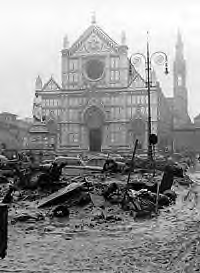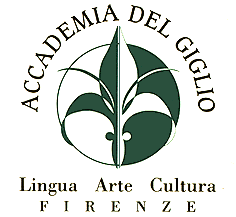 Quanti amano Firenze e le sono legati non possono evitare di ricordare una data che è e rimarrà scritta in modo indelebile nella storia di questa città: il 4 novembre 1966.
Quanti amano Firenze e le sono legati non possono evitare di ricordare una data che è e rimarrà scritta in modo indelebile nella storia di questa città: il 4 novembre 1966.
Si tratta di un giorno drammatico che ha segnato la storia non solo della città del giglio e del suo immenso patrimonio, ma anche di migliaia di persone accorse qui da tutto il mondo per restituire a Firenze e al mondo quanto la furia delle acque dell’Arno aveva sommerso. L’alluvione, questo terribile evento che lasciò quarant’anni fa una città distrutta, lacerata e sconvolta, torna con tutta la sua drammaticità negli occhi di chi racconta, per averla vissuta, quella terribile esperienza. Non è difficile infatti in questi giorni sentirne parlare, vista la quantità di iniziative che il Comune ha posto in essere per ricordare in modo significativo una data tanto infausta.
 Già tra sabato e domenica (4 e 5 novembre), in molte piazze e vie del centro era possibile assistere a proiezioni, cortei dei Vigili del Fuoco e delle Forze dell’Ordine, esercitazioni della Protezione Civile. In Piazza della Signoria, nella Loggia dei Lanzi, venivano proiettate immagini commemorative, mentre il Ponte Vecchio, il Biancone e la Torre di Arnolfo erano stati illuminati di viola, il colore di Firenze, per ricordare anche nell’oscurità della sera quanto fosse profonda la ferita che l’Arno aveva voluto infliggere alla sua città.
Già tra sabato e domenica (4 e 5 novembre), in molte piazze e vie del centro era possibile assistere a proiezioni, cortei dei Vigili del Fuoco e delle Forze dell’Ordine, esercitazioni della Protezione Civile. In Piazza della Signoria, nella Loggia dei Lanzi, venivano proiettate immagini commemorative, mentre il Ponte Vecchio, il Biancone e la Torre di Arnolfo erano stati illuminati di viola, il colore di Firenze, per ricordare anche nell’oscurità della sera quanto fosse profonda la ferita che l’Arno aveva voluto infliggere alla sua città.
Nella sala al piano terra di Palazzo Vecchio, è stata allestita una mostra fotografica relativa ai danneggiamenti portati dall’alluvione all’arte, ai musei e alle biblioteche di Firenze. La forza evocativa che proviene da quelle foto è quasi sconvolgente e restituisce la desolazione, il profondo senso di smarrimento di quei giorni, la disperazione e allo stesso tempo la voglia di ricominciare, il desiderio di “farcela”e la ferma volontà di restituire Firenze al mondo che sembrano dare nuovo vigore ai Fiorentini, agli Angeli del fango, alle Forze dell’Ordine e a quanti sono stati fotografati mentre si adoperano per recuperare dalla melma le opere d’arte più pregiate e amate al mondo.
La mostra è aperta fino a gennaio ed è ad ingresso libero.







However much one loves Florence and its legacy, one can not avoid of forget a date that remains indelibly written in the histor of this city: November 4, 1966.
It was a dramatic day that hasmarked the history of not just the city of lilies and its heritage, but also millions of people around the world who came here to restore Florence after the fury of the Arno’s waters had subsided.
The flood, whic forty years ago left a destroyed city, torn and bruised, returns with all its drama in the eyes of those who retell it, and those who livedthrough this terrible experience. It is not difficult in this day and age to see the amount of initiative the community displayed in order to remember this ill-fated day.
Today, between November fourth and fifth it is possible to see films, and watch parades of the Fire Department, Police force and Italian National Gruard. In the Piazza della Signoria, in the Loggia de Lanzi, they project commemerative images of the flood while illuminating the Ponte Vecchio, the Biancone and Arnolfo’s tower with purple lights–the color of the city of Florence–to remember the deep wound that the Arno inflicted on its city. On the first floor of the Palazzo Vecchio there is a photography exhibition highlighting the damages dome by the water to the art int he museums and libraries of Florence. The evocative force of those images bring back the desolation, the profound sense of loss of that day, along with the desperation and the desre to begin anew, the desire to make it and the volition to resore FLorence int he eyes of the world and the give new vigor to Florentines, to the Angels of Mus, to the police and to everyone who took pictures while trying to recover the most precious and beloved works of art in the world.
[…] This article has been translated into English by Will, Dressy and Margaret, students from Bard college. The original article is in Italian. « Un nuovo manuale di lettura e scrittura creativa The Medici’s Dinasty: Piero the Gouty » […]